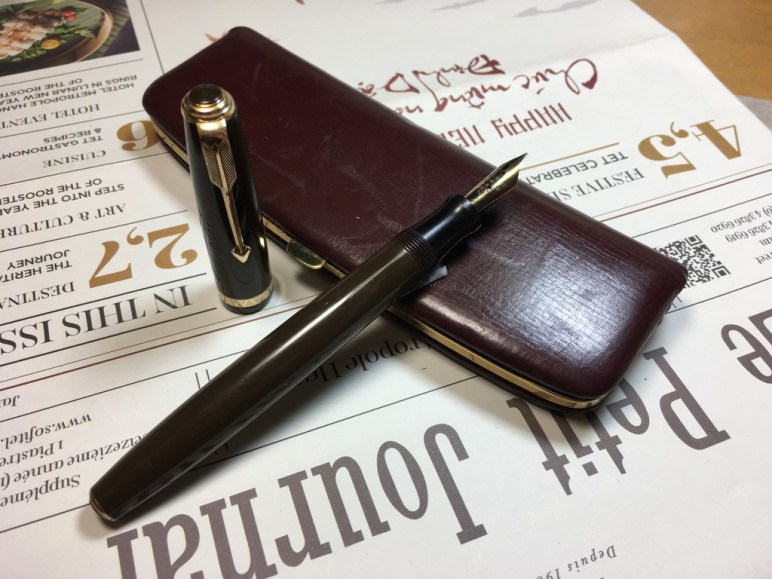I have to start somewhere. Pen repairing.
This whole lot of taking up arms and fight for my bonny lassies (pens, actually) gig didn’t come out of the blue. I’ve always been thinking about it, since most of the pens I collect are more than 50 years old, but have always procrastinated. Because I could. Because I had a great friend in my fountain pen aficionado circle who could be relied on when anything happened to my pens and needed fixing. His name was Mr. Lin Chien Chi. He led me into the realm of vintage fountain pens. He could do all sorts of pen repairs. His repair works were swift and impeccable.
He passed away in October, 2016.
The news sent many of us pen lovers in dismay. Not only was he a master repairman, he had also been an inspiration and a steadfast beacon for those of us who venture into the unknown seas of vintage fountain pens, always guiding us away from treacherous waters (pens, again), and cautioning us from certain product defects on certain pens.
My collection preferences closely resemble Mr. Lin’s. Soennecken, vintage British Parkers, and vintage Mont Blanc pens. His death meant that I will have to take the job of pen maintenance into my own hands. Well, most of the maintenance, since fountain pens have been around for over a century, and pens of different designs and inking mechanisms can really be a challenge. I am by no means exaggerating. I’ve been down this “rabbit hole”(or should I say “inky hole”) for three years, and I read pen-related articles rather vigorously. And after all this time, I am still discovering new pen brands or designs every other day. I suppose not even Mr. Lin could say that he could successfully repair every pen he receives or every model that ever came to be.
Thus it would be little surprise that I’ve decided to set my own brand focus. My main focus are vintage Parkers and Soennecken fountain pens. In the past three years, I’ve bought several books and magazines that have clear and sometimes coloured illustrations of fountain pens, including but not limited to, “Fountain Pens of the World” by Andreas Lambrou, and “Fountain pens, vintage and modern” also by Mr. Lambrou, and also “Pen Repair” by Jim Marshall and Lawrance Oldfield.
I’ve poured myself over the first two for ages, though it is often just the pages that concern my Soennecken collection targets. Those pictures of various pen models filled me with awe, secretly wishing I have the ability to materialize every pen I see in the pictures and send the money after (There’s no free supper!) Pen parts and tools are also needed, so after some extensive digging online, I found a few vendors who sells new parts for people who still use fountain pens extensively. 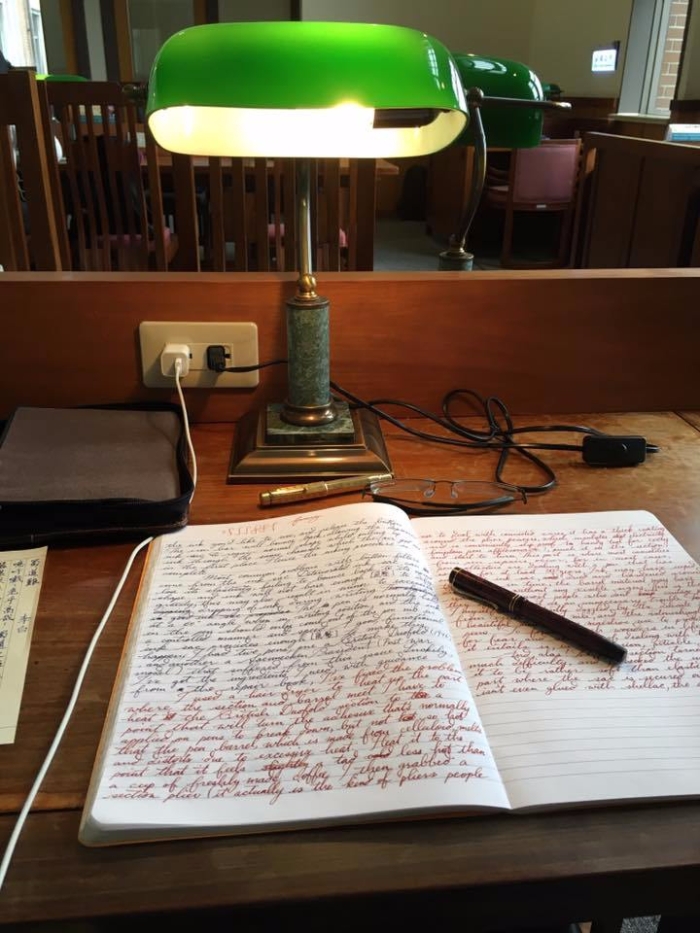
It sounded like an easy job, doesn’t it? A few clicks away, and I got all that I need to take care of my preciousssssssss pens. All of this were done in a course of three years, it’s the departure of Mr. Lin that prompted me to find the actual tools and parts. People who doesn’t use fountain pens might think that related pen information is abundant on the internet. The answer is both yes and no. There are, indeed, more and more information on the internet about vintage fountain pens provided by celebratd pen repairmen such as Richard Binder, John Mottishaw of Nibs.com, and Max from Penboard. However, they tend to focus on big brands such as Mont Blanc, Pelikan, Parker and others, for obvious economic and majority interests. Tragically, brands that are lesser known or vanished decades ago, or brands that make brilliant products but for some reason are no longer around often, or brands that only focus on local regions, receive little attention in the virtual world; at least, not in organised form. People would ask a question about some little known pen, and others with certain knowledge are often quite willing to share, and would come to the rescue. The information, if it has answered the question, would be very specific, and to-the-point, thus a more panoramic understanding of the pen model would still be absent after the discussion thread ended. Another problem that worsened this phenomenon is that most collectors who are knowledgeable in vintage pens are often the group of people who grew up without internet, and often prefer to record data and thoughts in pen and paper. I came to this revelation after fervent searches online of information about my beloved pen brand Soennecken for over a year. People keep referring to Mr. Lambrou’s books in discussion threads, hence why I’ve got both of them for my reference. They contain detailed information concerning the various pen models and descriptions of special features, and if he happen to be in possession or know someone who has a certain model, he would then supply pictures of the pens in his books. However, even for top collectors like Mr. Lambrou, it is still rather difficult to satiate my thirst for knowledge of the brand Soennecken. Some models can only be found on vintage catalogs, and most of the time these catalogs were printed before cameras and photos were prevalent and affordable. Lambrou’s books are of tremendous help, and the rest I would have to rely on empirical experiences from pen pals and my own purchases.
I’ve decided that before I lay my untrained hand on my precious Soennecken collection, I would start my pen restoration with mass production vintage pens, such as vintage Parker Duofolds, Vacumatics, and the 51s. These models have different inking mechanisms, and because Parker used to be one of the largest pen manufacturers in the world, its pen model designs are often adapted or used by other smaller manufacturers. Thus the skills learned from those pens can be somewhat applicable to other models of different make. Another reason would be that these pens are fairly easy to come by, and often at decent prices.
So, Parker Duofolds. These are often big pens with large ink sacs that carry a heavy load of ink for daily use. These models receive a lot of attention online, so I will just briefly introduce them to those who aren’t familiar with them.
Parker Duofold was first introduced in 1921. It was first presented in an orange/red, with a gold band on the cap band, and black, flat hard rubber finishes at the cap top, and slightly tapered at the end cap. One must understand that before the Duofold, very few non-metal fountain pens came in colours other than black. It was a salesman’s idea to give the company’s product line a little new look. It became an instant hit. I’ve seen a couple websites with old advertisements depicting Duofold pens unscathed after being tossed off the Berlin broadcasting tower to demonstrate its sturdiness. I have a couple of other ads from back in those days:
The Duofold featured a 14k gold nib, and with a patented ink feed that the part under the nib looks like the shape of a Christmas tree. The other end of the pen feed would be the famous Parker feed design, the “Lucky curve”, a tweak in the feed shape formation in order to stop excessive ink gushing into the ink channels.
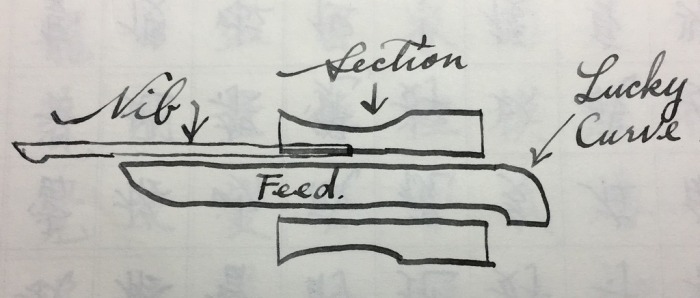
The Duofold were subsequently issued in different sizes, the senior, junior, and lady sizes, with the senior sized Duofold measuring over 5 inches long when capped. It later had other colours available, including but not limited to: Lapis blue, Mandarin yellow, Jade green, and Pearl nacre. As the years gone by, many other Parker pens were redesigned from, or inspired by the original Duofold: The Pastels, British Duofold (yes, I know the British line is quite another story, but it did keep the name, didn’t it?), the Parkettes and so on. A couple European brands also made products that look identical with the Parker Duofold.
It is still in production today, but with redesigned looks, nibs, and inking mechanism. The Duofold’s importance in fountain pen history equates Sir Isaac Newton historical stance in modern science.
Enough of the history lessons. The Duofold is a large button-filler. What is a button-filler? It refers to the inking mechanism that is activated by a button (normally made from brass) at the pen’s rear.When pressed, the button retreats into the barrel, simultaneously transmitting the force to an iron bar installed beneath the button. The iron bar is made thin and elastic, and it bends under force, squeezing the ink sac that sits snugly next to it inside the barrel. The ink sac releases air out of the barrel through the tiny vents carved on the feed and finally exits the pen from the nib’s vent hole, nib slit and feed. The user then dip the pen nib into the ink and release the button. The iron bar would bounce back, allowing the depressed ink sac to regain its normal shape whilst pulling up ink through the same channels which the air got out in the first place with pneumatic force. Hence the inking procedure is complete.
Common problems with button-fillers associate with the ink sac. Deteriorated ink sac can lose elasticity, resulting in failure to bounce back to its normal shape and ink will not have enough pneumatic pressure to defy gravity; this may also result in minor to excessive dripping of ink during writing sessions. A fountain pen is normally held at a 60 degree angle when writing, and the ink in the pen should only come out from the tip in a controlled manner. A good, functional ink sac provides enough pneumatic pressure to make this happen. I had two pens, one a British Duofold (1946 model version) that suffered from this issue. Luckily, I’ve got the ingredients I need, with guidance from the “Pen Repair” book, I’ve fixed the problem.
I used a hair-dryer to heat up the part where the section and barrel meet. I had to heat the British Duofold section to a point that will turn the shellac (an adhesive normally applied on pens, is tested and proven safe to plastic, acrylic, celluloid, hard rubber and many other materials that are used to make fountain pens) brittle, but not too hot that the pen barrel, which is made from celluloid, melts and distorts. If I were to describe how hot it should be, I suppose heating it to the point that it feels a tad less hot than a cup of freshly made coffee.
I then grabbed a section plier ( it actually is the kind of pliers people use to deal with power-lines or wires; it has a thick coating around the plier pincers, which insulates electricity, and is conveniently slip-proof. A handy tool for every fountain pen aficionado.) , pinch it on the section, and started to turn. This part is where most casualties from pen repairs occur, since, in most cases, pen collectors are dealing with a pen that has roamed this Earth for more than 30 years (in this case, 71!) Ink may have seeped out of the ink sac, dried and hardened around the section in time; or, barrel material may have deteriorated without any visible signs (See my 1306 below.)
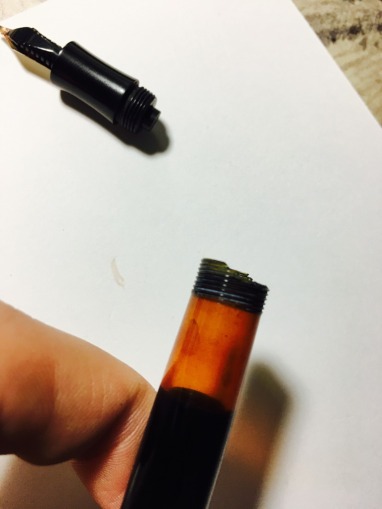
This is the main reason why some people don’t collect vintage pens as they see the occasional demises as unnecessary trouble and risk. I myself am forever dazzled by the delicate feedback from vintage nibs and the astonishingly beautiful materials pen maestros use to produce the pens. To forsake such wonder in life for fear and reluctance of dealing with the trouble magnificence entails is, in my opinion, pitiable. And alas!
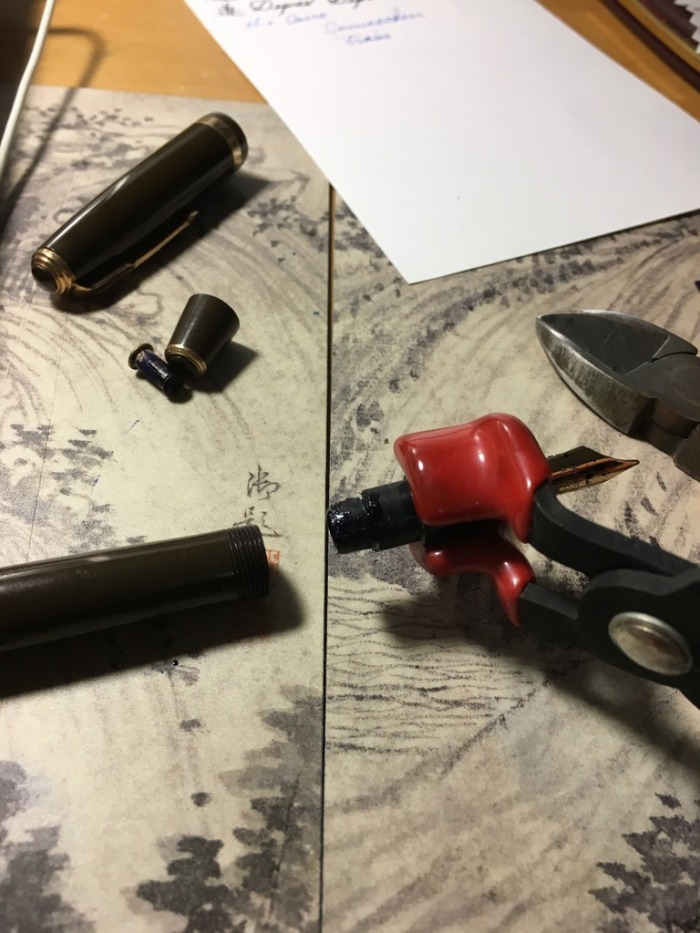
The section turned without much difficulty, and I checked the ink sac, found it to be rather soft. Also, the part where the sac is secured onto the section isn’t glued with shellac. This is not unheard of, as I’ve confirmed with a friend of mine who has had more experiences in pen repairs, for newly installed ink sacs have good elasticity and could hold onto the section airtight. I pulled the pen apart, save knocking out the nib out of the section since there is no need to do so, the nib and feed are ok.
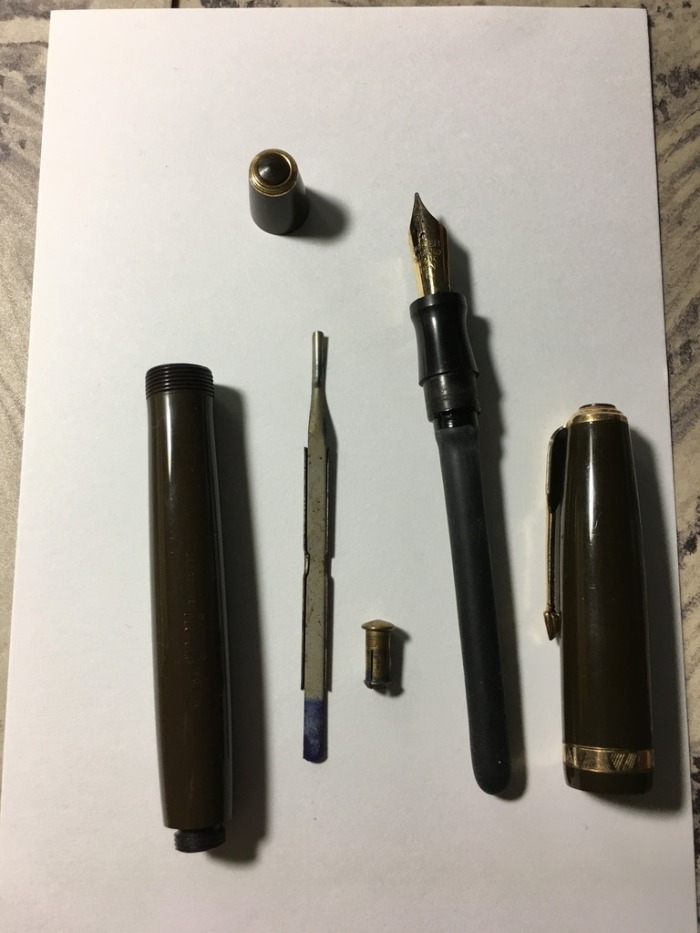
I fished out a new ink sac, cut it to good length, and glued it onto the section. I had to do this again ten minutes later, for I was too eager to check the results and pulled off the ink sac before the shellac dried. Rookie mistake. Art cannot be rushed. Shellac’s the same.
After gluing the sac, I also checked the iron bar and found it in working condition. After thirty minutes, I fitted everything in place, glued the pen back together, and waited. Nervously. Wondering if I have done everything correctly. This was my first repair after all. I inked up the pen after I’ve busied myself with other errands for roughly thirty minutes and started writing. Ink sac works properly. No dripping from the feed, either. No blobbing ink.
I’ve done it!!!
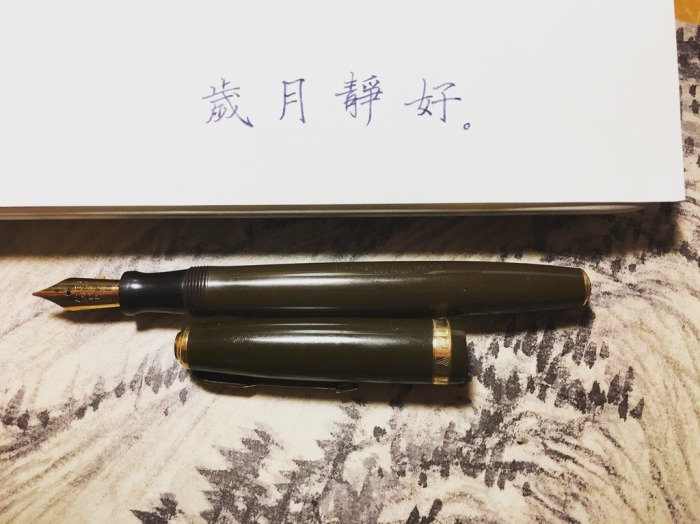
End of my first pen repair. Scottie out.
